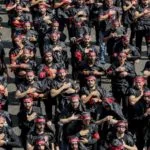
(NEW YORK) — In the days after Hamas’ surprise attack on Israel from Gaza, Israeli forces have also been engaging in skirmishes with Hezbollah along Israel’s northern border with Lebanon.
The Israeli Defense Forces said Tuesday that more than a dozen rockets were launched from Lebanese territory, and that the probability of an escalation along the border is “not low.”
The developments come after Israeli Prime Minister Benjamin Netanyahu said Monday one of the key priorities in the war against Hamas is fortifying its northern border against Hezbollah, a Lebanese militant group.
Here’s what to know about Hezbollah:
What is Hezbollah?
Hezbollah — which means “party of God” or “party of Allah” — is an Iran-backed, Shiite Muslim political party and militant group based in Lebanon. It was founded in the 1980s amid the 15-year Lebanese Civil War and has been led by its Secretary-General Hassan Nasrallah since 1992. Today, it controls much of the Shiite-majority areas of Lebanon, including parts of the capital, Beirut.
Hezbollah has been designated a terrorist organization by multiple countries, including the U.S. and Israel.
The group has clashed for decades with Israel, which is considered Hezbollah’s “main enemy,” going back to Israel’s occupation of southern Lebanon in 1978, according to the Council on Foreign Relations, a New York City-based independent think tank.
“Even after Israel officially withdrew from southern Lebanon in 2000, it continued to clash with Hezbollah,” including in a monthlong war in 2006, the Council on Foreign Relations said.
Hezbollah has been blamed for multiple terrorist attacks on Jewish and Israeli targets abroad. Its reach isn’t limited to Lebanon, with “evidence of Hezbollah operations in Africa, the Americas, and Asia,” according to the Council on Foreign Relations.
The group has also been involved in the Syrian civil war, joining Iran and Russia in support of the Syrian government.
As a political party, Hezbollah and its allies lost their majority in Lebanon’s 128-member Parliament in last year’s elections. Though “it remains the dominant party of the Shiite community and an extremely powerful armed group that does not hesitate to use force inside, and outside, the country to pursue its or Iran’s goals,” the Middle East Institute, a Washington, D.C.-based non-partisan think tank, said at the time.
What is the difference between Hamas and Hezbollah?
Hamas and Hezbollah are united in rejecting Israel’s right to exist and are considered terrorist groups by the U.S., Israel and other countries.
They are both Islamic militant groups, though Hamas belongs to the Sunni branch and Hezbollah the Shia branch.
Hamas controls the Palestinian territory of Gaza, located on Israel’s southwestern border, while Hezbollah is based in Lebanon, on Israel’s northern border.
Iran has long been known to provide support, training and weapons to both armed resistance groups, which are considered to be the largest in a network of Tehran proxy groups on Israel’s borders.
“Iran seems to be the head of the ‘octopus of terror.’ One arm Hezbollah, another Hamas,” Naftali Bennett, the former prime minister of Israel, said during a briefing organized by Jewish Federations of North America on Tuesday.
Is Hezbollah involved in the Israel-Hamas conflict?
Since the Hamas assault, there has been some fighting along the Israel-Lebanon border. On Monday, the Israel Defense Forces said it “neutralized a number of terrorist infiltrators who crossed from Lebanon into Israel.” Hezbollah claimed three militants were killed in the fighting that day.
The Israel Defense Forces said Tuesday it attacked Hezbollah observation posts in response to approximately 15 rockets launched from Lebanese territory.
“On the northern border, Hezbollah is playing games. Not big numbers, but they try to infiltrate,” Bennett said.
The U.S. is “deeply concerned” about the possibility of Hezbollah opening a second front to Israel’s fight and is “working with Israel and with our partners across the region to contain this to Gaza,” a senior U.S. official told reporters Monday.
As a deterrent, the U.S. has moved the USS Gerald R. Ford Carrier Strike Group to the eastern Mediterranean.
“These posture increases were intended to serve as an unequivocal demonstration in deed, and not only in words, of U.S. support for Israel’s defense and serve as a deterrent signal to Iran, Lebanese Hezbollah and any other proxy across the region who might be considering exploiting the current situation to escalate conflict,” the official said.
It is unclear if Iran has played a critical role in orchestrating the Hamas attack. On Monday, White House spokesperson John Kirby said although Iran bore “a degree of complicity,” the administration had yet to uncover “hard, tangible evidence” of its involvement.
Copyright © 2023, ABC Audio. All rights reserved.
